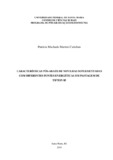| dc.creator | Cattelam, Patrícia Machado Martini | |
| dc.date.accessioned | 2019-06-05T16:14:25Z | |
| dc.date.available | 2019-06-05T16:14:25Z | |
| dc.date.issued | 2019-02-15 | |
| dc.identifier.uri | http://repositorio.ufsm.br/handle/1/16756 | |
| dc.description.abstract | The objective of the present study was to evaluate the effect of three different energy sources on carcass characteristics, non-carcass components and meat quality of heifers finished in Tifton 85 pasture. Thirty heifers were used, with age and initial weight of 26 months and 274.5 kg, originating from the rotational cross between the Charolais and Nelore races. The experimental design was completely randomized. The animals were distributed evenly for weight and genetic group in three energy sources: corn grain, white oats or barley, the level of supplementation was 1% PV. The mean cold carcass weight and yield was 218.2 kg and 53.5%. The subcutaneous fat thickness was 4.37 mm, the metric measures, percentage of tissues, primary cuts and sensorial characteristics of the meat were not altered by feeding strategies. The slaughter weights (SW), empty body weight (EBW) and the EBW/SW ratio were similar between the supplementation strategies. The total organ weight of 100 kg EBW was higher for heifers fed corn than those receiving white oats, with intermediate behavior for females receiving barley, 3.43; 3.22 and 3.29%, respectively. The weight of rumen-reticulum relative to 100 kg of EBW was 11% higher for females that received barley than those that received white oats, and intermediate behavior for corn, 1.72; 1.55 and 1.63% PCVZ, respectively. The weight of the gastrointestinal tract, peripheral components and discarded fats did not differ between the energy sources used. White oat grain or barley may replace corn grain and provide adequate development of the carcass of beef cattle in Tifton 85 pasture. | eng |
| dc.language | por | por |
| dc.publisher | Universidade Federal de Santa Maria | por |
| dc.rights | Attribution-NonCommercial-NoDerivatives 4.0 International | * |
| dc.rights.uri | http://creativecommons.org/licenses/by-nc-nd/4.0/ | * |
| dc.subject | Componentes não carcaça | por |
| dc.subject | Cynodon spp | por |
| dc.subject | Fêmeas | por |
| dc.subject | Qualidade da carne | por |
| dc.subject | Cynodon spp | eng |
| dc.subject | Females | eng |
| dc.subject | Meat quality | eng |
| dc.subject | Non-carcass components | eng |
| dc.title | Características pós-abate de novilhas suplementadas com diferentes fontes energéticas em pastagem de Tifton 85 | por |
| dc.title.alternative | Post-about characteristics of supplemented heifers with different energy sources in pasture Tifton 85 | eng |
| dc.type | Dissertação | por |
| dc.description.resumo | O presente estudo teve por objetivo avaliar o efeito de três fontes energéticas distintas, sobre as características da carcaça, os componentes não carcaça e a qualidade da carne de novilhas terminadas em pastagem de Tifton 85. Foram utilizadas 30 novilhas, com idade e peso inicial de 26 meses e 274,5 kg, oriundas do cruzamento rotativo entre as raças Charolês e Nelore. O delineamento experimental utilizado foi o inteiramente casualizado. Os animais foram distribuídos uniformemente quanto ao peso e grupo genético em três fontes energéticas: grão de milho, aveia branca ou cevada, o nível de suplementação foi de 1% PV. O peso e rendimento de carcaça fria médio foi de 218,2 kg e 53,5%. A espessura de gordura subcutânea foi de 4,37 mm, as medidas métricas, percentuais de tecidos, de cortes primários e características sensoriais da carne não foram alteradas pelas estratégias de alimentação. Os pesos de abate (PA), peso de corpo vazio (PCVZ) e a relação PCVZ/PA foram similares entre as estratégias de suplementação. O peso total de órgãos relativo a 100 kg de PCVZ, foi maior para as novilhas alimentadas com milho em relação as que receberam aveia branca, com comportamento intermediário para as fêmeas que receberam cevada, 3,43; 3,22 e 3,29%, respectivamente. Já o peso de rúmen-retículo relativo a 100 kg de PCVZ foi 11% superior para as fêmeas que receberam cevada em relação as que receberam aveia branca, e comportamento intermediário para grão de milho,1,72; 1,55 e 1,63% PCVZ, respectivamente. O peso do trato gastrointestinal, componentes periféricos e gorduras descartadas não diferiram entre as fontes energéticas utilizadas. O grão de aveia branca ou cevada pode substituir o grão de milho e proporcionar adequado desenvolvimento da carcaça de bovinos terminados em pastagem de Tifton 85. | por |
| dc.contributor.advisor1 | Brondani, Ivan Luiz | |
| dc.contributor.advisor1Lattes | http://lattes.cnpq.br/5813089147720195 | por |
| dc.contributor.advisor-co1 | Alves Filho, Dari Celestino | |
| dc.contributor.advisor-co1Lattes | http://lattes.cnpq.br/2140386505744337 | por |
| dc.contributor.referee1 | Pascoal, Leonir Luíz | |
| dc.contributor.referee1Lattes | http://lattes.cnpq.br/6500944541004301 | por |
| dc.contributor.referee2 | Missio, Regis Luis | |
| dc.contributor.referee2Lattes | http://lattes.cnpq.br/9307210422715885 | por |
| dc.creator.Lattes | http://lattes.cnpq.br/5846130905074611 | por |
| dc.publisher.country | Brasil | por |
| dc.publisher.department | Zootecnia | por |
| dc.publisher.initials | UFSM | por |
| dc.publisher.program | Programa de Pós-Graduação em Zootecnia | por |
| dc.subject.cnpq | CNPQ::CIENCIAS AGRARIAS::ZOOTECNIA | por |
| dc.publisher.unidade | Centro de Ciências Rurais | por |



